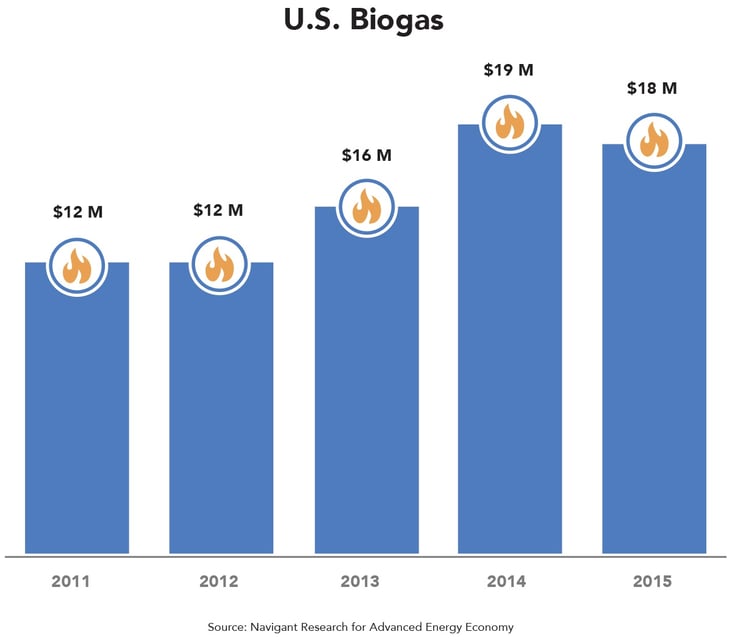This post is one in a series of feature stories on trends shaping advanced energy markets in the U.S. and around the world, drawn from Advanced Energy Now 2016 Market Report, which was prepared for AEE by Navigant Research.

Biogas for commercial use is a product of anaerobic digestion, a method in which microorganisms break down organic matter in an oxygen-starved environment, and one of the oldest processing technologies. It is captured in modern land fills (land fill gas, or “LFG”) and biodigesters, which treat a range of organic waste streams. While biogas is a combination of gases and other volatile impurities, its main component (50% to 70%) is methane (CH4), the same as natural gas. As such, biogas can be combusted to produce electricity and heat. It can also be upgraded to pure biomethane or renewable natural gas (RNG) through the process of removing the impurities and other gases, making it suitable for transport by pipeline or compressed to fuel CNG vehicles.
Biogas power generation is widely utilized for on-site generation by industrial-scale facilities and distributed customers alike. Offering reliable baseload power to the grid, biogas enjoys favorable regulatory support in many national markets and is expected to play a signi cant role in meeting expanding renewable energy targets. The four main feedstock sources within the global biogas market are food waste, industrial, agricultural, and sewage.
Biogas feedstocks are available worldwide. However, logistical challenges associated with its collection, aggregation, transportation, and handling, coupled with poor energy density relative to fossil fuels, make power and fuel generation from biogas viable only where organic matter is available in large quantities and in continuous supply.
Overall, Biogas fuel production revenue and capital expenditures on processing equipment together was $86 million worldwide in 2015, up 67% from the year before and 83% over 2011. In the United States, Biogas revenue was down 6% from the recent peak of $19 million in 2015, but still up 44% from 2011, when it was $12 million. But year-to-year variation is mostly due to the ebb and flow of capital investment in biogas facilities. Revenue from Biogas fuel production has risen steadily over the 2011-15 period, from $27 million to $57 million globally, and from $8 million to $13 million domestically.
In the United States, there are numerous companies that have formed in the last decade as biogas technologies have manifested. For example, Harvest Power operates an anaerobic digester in Orlando, Florida, in which food waste sourced primarily from the Walt Disney World Resort is used to produce enough electricity to meet the needs of 16,000 homes. 2G Energy Inc. is another U.S.-based company, which utilizes biogas for CHP plants. The company has over 40 biogas plants across North America ranging in capacity from less than 100 kW to over 2.8 MW. The Florida-based company utilizes LFG and sewage sludge from wastewater treatments as the primary sources of organic material for its CHP plants. Bluesphere, based in North Carolina, is currently building a 5.2 MW biogas plant in Charlotte, which is scheduled to be completed in 2016. The company is also building a biogas plant in Rhode Island, as well as multiple plants in Italy.
Driven by strong waste management and renewables integration policies, Europe is expected to hold its position as the leading region worldwide for the next decade, with Germany as the epicenter of global biogas production.
The European biogas market is currently led by on-farm digesters, with Germany accounting for 52% of total biogas production capacity, most of which is used for electricity production. In 2014, the country had 3,840 MW of installed capacity, the most biogas electricity generation capacity in the world.
In the United States, policies to enforce the composting and recycling of organic material are beginning to gain traction, which could spur more biogas development. Massachusetts is the rst state to enact a food-waste disposal ban, which requires any entity that disposes of more than one ton of organic material per week to donate or re-purpose the material instead of sending it to a land ll. The material is to be used for a variety of applications including sending it to anaerobic digestion facilities to convert it to renewable natural gas. Should other states follow suit, biogas could be in a position to gain a substantial foothold in the renewable energy market.
Learn more about renewable natural gas and other aspects of the advanced energy industry in our annual Advanced Energy Now Market Report, available for free at the link below:
